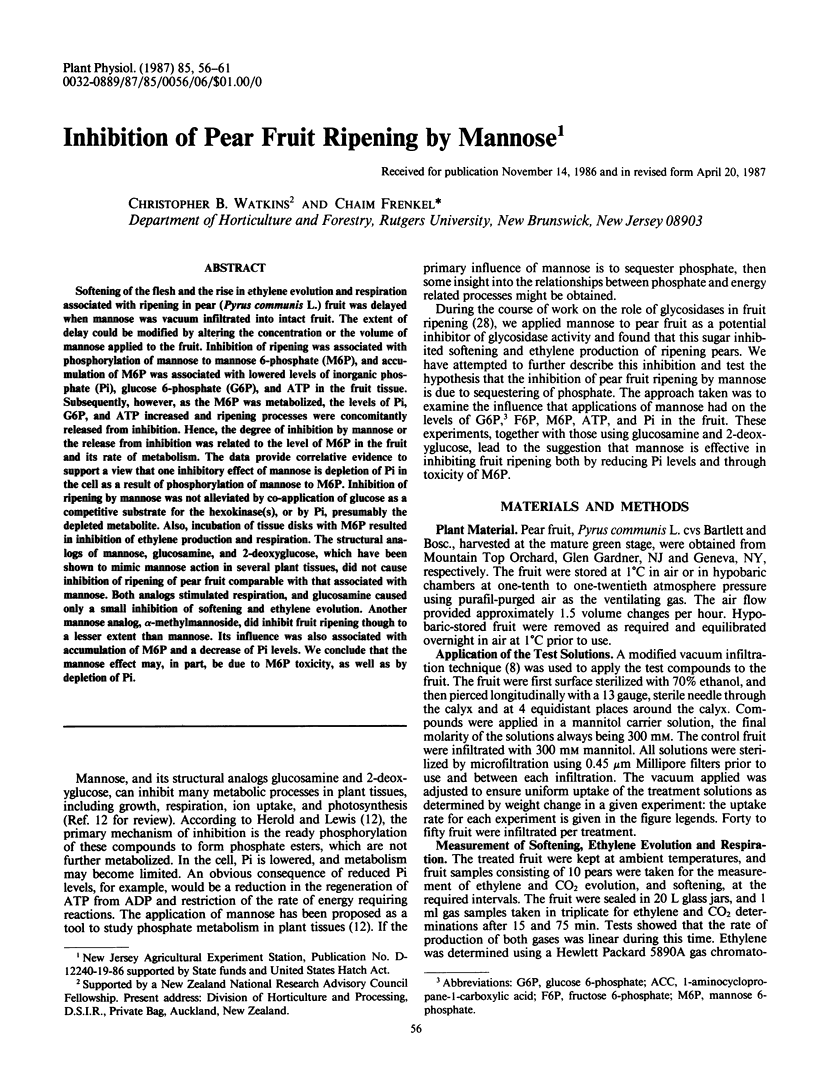Abstract
Softening of the flesh and the rise in ethylene evolution and respiration associated with ripening in pear (Pyrus communis L.) fruit was delayed when mannose was vacuum infiltrated into intact fruit. The extent of delay could be modified by altering the concentration or the volume of mannose applied to the fruit. Inhibition of ripening was associated with phosphorylation of mannose to mannose 6-phosphate (M6P), and accumulation of M6P was associated with lowered levels of inorganic phosphate (Pi), glucose 6-phosphate (G6P), and ATP in the fruit tissue. Subsequently, however, as the M6P was metabolized, the levels of Pi, G6P, and ATP increased and ripening processes were concomitantly released from inhibition. Hence, the degree of inhibition by mannose or the release from inhibition was related to the level of M6P in the fruit and its rate of metabolism. The data provide correlative evidence to support a view that one inhibitory effect of mannose is depletion of Pi in the cell as a result of phosphorylation of mannose to M6P. Inhibition of ripening by mannose was not alleviated by co-application of glucose as a competitive substrate for the hexokinase(s), or by Pi, presumably the depleted metabolite. Also, incubation of tissue disks with M6P resulted in inhibition of ethylene production and respiration. The structural analogs of mannose, glucosamine, and 2-deoxyglucose, which have been shown to mimic mannose action in several plant tissues, did not cause inhibition of ripening of pear fruit comparable with that associated with mannose. Both analogs stimulated respiration, and glucosamine caused only a small inhibition of softening and ethylene evolution. Another mannose analog, α-methylmannoside, did inhibit fruit ripening though to a lesser extent than mannose. Its influence was also associated with accumulation of M6P and a decrease of Pi levels. We conclude that the mannose effect may, in part, be due to M6P toxicity, as well as by depletion of Pi.
Full text
PDF





Selected References
These references are in PubMed. This may not be the complete list of references from this article.
- Apelbaum A., Wang S. Y., Burgoon A. C., Baker J. E., Lieberman M. Inhibition of the Conversion of 1-Aminocyclopropane-1-carboxylic Acid to Ethylene by Structural Analogs, Inhibitors of Electron Transfer, Uncouplers of Oxidative Phosphorylation, and Free Radical Scavengers. Plant Physiol. 1981 Jan;67(1):74–79. doi: 10.1104/pp.67.1.74. [DOI] [PMC free article] [PubMed] [Google Scholar]
- Blum J. J., Wittels B. Mannose as a metabolite and an inhibitor of metabolism in Euglena. J Biol Chem. 1968 Jan 10;243(1):200–210. [PubMed] [Google Scholar]
- Frenkel C., Dyck R. Auxin inhibition of ripening in bartlett pears. Plant Physiol. 1973 Jan;51(1):6–9. doi: 10.1104/pp.51.1.6. [DOI] [PMC free article] [PubMed] [Google Scholar]
- Latzko E., Gibbs M. Measurement of the intermediates of the photosynthetic carbon reduction cycle, using enzymatic methods. Methods Enzymol. 1972;24:261–268. doi: 10.1016/0076-6879(72)24073-3. [DOI] [PubMed] [Google Scholar]
- Meir S., Philosoph-Hadas S., Epstein E., Aharoni N. Carbohydrates stimulate ethylene production in tobacco leaf discs : I. Interaction with auxin and the relation to auxin metabolism. Plant Physiol. 1985 May;78(1):131–138. doi: 10.1104/pp.78.1.131. [DOI] [PMC free article] [PubMed] [Google Scholar]
- Negm F. B., Loescher W. H. Characterization and Partial Purification of Aldose-6-phosphate Reductase (Alditol-6-Phosphate:NADP 1-Oxidoreductase) from Apple Leaves. Plant Physiol. 1981 Jan;67(1):139–142. doi: 10.1104/pp.67.1.139. [DOI] [PMC free article] [PubMed] [Google Scholar]
- Riov J., Yang S. F. Stimulation of ethylene production in citrus leaf discs by mannitol. Plant Physiol. 1982 Jul;70(1):142–146. doi: 10.1104/pp.70.1.142. [DOI] [PMC free article] [PubMed] [Google Scholar]
- SOLS A., CADENAS E., ALVARADO F. Enzymatic basis of mannose toxicity in honey bees. Science. 1960 Jan 29;131(3396):297–298. doi: 10.1126/science.131.3396.297. [DOI] [PubMed] [Google Scholar]


